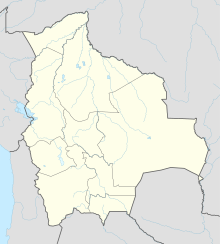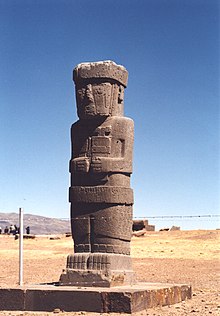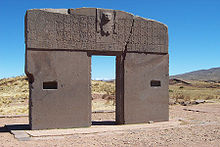Tiahuanaco
Coordinates: 16 ° 33 ′ 18 ″ S , 68 ° 40 ′ 25 ″ W.
Tiahuanaco ( Aymara spelling Tiwanaku ) is an important ruin site of pre-Inca cultures near the town of Tiawanacu in western Bolivia . The ruins are among the most important archaeological sites in Bolivia and were included in the UNESCO World Heritage List in 2000 . Only a fraction of the former city was excavated and examined by archaeologists.
location
The ruins are located on the temporarily dry Río Tiwanaku in the barren plateau of the Altiplano at an altitude of almost 4,000 m , approx. 75 km (driving distance) west of La Paz on the main road to Desaguadero (border crossing to Peru ) and 15 km southeast of Lake Titicaca .
Discovery and history of research
The conquistador Francisco Pizarro is said to have visited and plundered the area in 1532. The remains of the city were first described in the 16th century by Pedro de Cieza de León ; he came across the ruins in 1549 while looking for the capital of the Incas at Qullasuyu . The German naturalist Moritz Alphons Stübel was one of the first to undertake excavations in Tiahuanaco.
Among the first explorers of the modern age were Max Uhle , who visited the place when it was still a training area for the Bolivian army, and Arthur Posnansky , who managed to photograph the remains before Tiahuanaco became the important quarry for the church, secular and railway construction was. The first stratigraphic dig was headed by archaeologist Wendell Clark Bennett in 1934 . Three decades later, the Peruvian Luis Lumbreras uncovered further ceramic artefacts from the early, classical and late cultural succession , which confirmed Bennett's earlier hypotheses: The leading ceramics therefore show clear leaps in style. After initially hemispherical jugs and round-bellied bottles with bulging necks predominated, which were decorated with complex geometric patterns and animal drawings, cup-shaped keros in the style of the Nazca culture dominated in the Middle Classical period . These, too, are richly ornamented with symbolic animals and carry novel cultic-martial elements such as headhunters and beheaded. In the "decadent" or "expansive" late phase, patterns and colors became increasingly impoverished, and ceramics became a pure commodity for the caravan trade.
history
Historic Tiahuanaco was the religious and administrative center of pre-Inca cultures around Lake Titicaca in 1500 BC. BC to AD 1200. The language was probably Puquina . The first traces of settlement date from the 15th century BC. Around 300 BC Tiahuanaco began to grow into a center for religion and culture and reached its peak between AD 600 and AD 900.
By determining the age of excavated ceramic objects , chronological phases can be recognized, which between 300 BC. And 1000 AD. The main phase of development could also be narrowed down to the period between AD 600 and AD 900 by multiple dating using the C14 method , which corresponds to the chronology of the ceramic phases IV and V. In its heyday, Tiahuanaco's influence ranged from the Atacama Desert on the Pacific coast to the province of Cochabamba and parts of what is now Argentina .
At the end of the first millennium, Tiahuanaco fell victim to a climatic change and the associated drought . This led to the city being abandoned for many years. Contrary to what Posnansky had previously assumed, Tiahuanaco was not located directly on Lake Titicaca, but was dependent on rain agriculture, for which advanced irrigation and storage systems were built in the fields around Tiahuanaco.
When the Incas reached the area, they found Tiahuanaco already deserted. During the Spanish colonial era , the historic area was looted and used as a quarry well into the 20th century. Most researchers see in today's Aymara population of the Titicaca Basin descendants of the earlier heterogeneous population of the Tiahuanaco region, the Lupaca and Pacajes , who were absorbed into the Aymara after the 16th century. Other researchers consider the pukina to be the bearer of the early Tiahuanaco dynasties.
Stone processing
The andesite stones used in Tiahuanaco for architectural and sculptural purposes all come from the surrounding area; longer transports were therefore not necessary. Their surface treatment was carried out with the help of rubstones made of the same or - if available - a harder material. Small-scale structures could not be created in this way, but at least ornamental motifs such as tattoos or fabric patterns could be imitated by hammering and scratching with stone points . It can be assumed that most of the buildings and sculptures were painted in color despite the lack of plastering marks .
investment
The actual ceremonial center of Tiahuanaco consists of several assemblies, all of which are geared towards the two equinoxes :
- The Patio Hundido ("sunken courtyard") is an almost square complex with a side length of around 28 m; it is located approximately to the east of the complex and is surrounded by walls around 2 m high and decorated with stone heads. Here in 1932 the 7.20 m high and almost 20 t heavy Bennett monolith was excavated, which is now in the local museum.
- The double gate leading up to the Kalasasaya platform provides a view of the monolithic stone figure of the Ponce monolith, which is roughly in the middle of the inner platform . The two parts of the platform are surrounded by two rectangular walls, no more than 3 m high, the outer walls of which consist of erected megaliths with intervening, partially restored fillings made of precisely hewn stones; the megaliths are missing from the inner wall.
- The "Ponce Monolith" is around 3.50 m high including the base. The figure depicted is of high rank, which can be seen, among other things, from his pigtails and arm tattoos. He holds two (ceremonial) objects in his hands, which are hugged close to his body. Its ornamented hip belt encloses the upper end of an ornamented wrap-around pants .
- Another figure, given the name El Fraile ("monk"), stands in the southwest corner of the platform. There are no tattoos on his arms; however, a cross was carved by the Spaniards on his right shoulder. His hip belt, which also holds a pair of wrap pants, is decorated with crab motifs.
- The monolithic but broken and reassembled Puerta del Sol ("Sun Gate") rises within the northwest side of the larger platform.
- Outside the east wall of the platform is the Putuni ("Palace of the Sarcophagi").
- Outside the north side of the platform rises the Akapana pyramid, which was once piled up by people and is now only about 15 m high, with its wall edging made of megaliths and filler stones.
- Compared to the “Sun Gate”, the Puerta de la Luna (“Moon Gate”) is much slimmer, but also monolithic, and is located about 200 m northwest of the Kalasasaya platform.
- Surroundings
- A few hundred meters away is the Puma Punku field of ruins , whose extremely precisely hewn monoliths are said to belong to a destroyed building of the Aymara culture.
Attractions
- The most famous sight is the Sun Gate . It is about 3 m high and 3.75 m wide and was carved out of a single andesite block using perfectly crafted stone processing . After the fall of the culture, probably overturned by an earthquake and broken in two, it was rebuilt in 1908. Its weight is estimated at seven to twelve tons. On it is a frieze with a deity (probably Wiraqucha or in Aymara : Willkatata ) who holds two serpent scepter in her hands. The mask-like face is framed by a radial headdress . This motif is also found on the Raimondi stele from Chavín de Huántar . The winter solstice ( Willakakuti or Willkatuti), the New Year's festival of the Aymara , is celebrated annually at the Sun Gate . The central figure is framed by numerous reliefs of kneeling "bird people", each holding a kind of ceremonial staff in their hands. The reliefs in the lower row differ from the "bird people" in the three upper relief rows because of their predominantly geometric character.
- The most important sculpture from Tiahuanaco is the approximately 3.50 m high so-called "Ponce Monolith". His face is rigidly forward; the wide-open eyes as well as the mouth and broken nose are shown rather schematically. He wears a cap with hanging earmuffs on his head. His arms close to his body seem to be tattooed; the hands in front of the stomach hold two ceremonial objects. From the hip down, the figure shown wears a trouser-like, wrapped, ornamented trousers; the hip itself is of a thick cloth belt with cancer designs surrounded.
Literature (in chronological order)
- Edmund Kiss : The Sun Gate of Tiwanaku and Hörbiger's World Ice Theory , Leipzig 1937.
- Arthur Posnansky: Tihuanacu. The cradle of American man , New York 1945.
- Bertrand Flornoy: Enigmatic Inca Empire - the history of the great Indian people , Zurich 1956.
- Hans S. Bellamy: The calendar of Tiahuanaco - a disquisition on the time measuring system of the oldest civilization in the world , London 1956.
- Alan Kolata: The Tiwanaku - portrait of an Andean civilization , Cambridge 1993, ISBN 1-55786-183-8 .
- Helene Gerov, (et al.): Technology from pre-Inca cultures - Tiahuanaco , Vienna 1995.
- Henri Stierlin: The art of the Inca and their forerunners - from Valdívia to Machu Picchu , Stuttgart 1997, ISBN 3-7630-2349-6 .
- Garret G. Fagan: The seventy great mysteries of the ancient world. Unlocking the secrets of past civilizations , New York 2001.
- John Wayne Janusek: Identity and Power in the Ancient Andes: Tiwanaku Cities Through Time , London a. New York 2004, ISBN 0-415-94634-4 .
- David M. Jones: The illustrated history of the Incas - the extraordinary story of the lost world of the Andes, chronicling the ancient civilizations of the Paracas, Chavin, Nasca and Moche and other tribes and cultures of ancient South America , London 2007, ISBN 1-84476-369-2
- Garret G. Fagan (Ed.): Archaeological fantasies. How pseudoarchaeology misrepresents the past and misleads the public , Abingdon et al. 2007.
- Walt Becker: Missing Link , Munich 2008, ISBN 978-3-426-50003-3 .
- Doris Kurella: Cultures and Buildings of Ancient Peru. History in the backpack (= Kröner's pocket edition . Volume 505). Kröner, Stuttgart 2008, ISBN 978-3-520-50501-9 .
Web links
- Entry on the UNESCO World Heritage Center website ( English and French ).
- Tiahuanaco - plan sketch, photos + information
- Travel report Bolivia - From La Paz to the important pre-Inca site of Tiwanaku at an altitude of almost 4,000 m ... Photos and text. In: astrosoft.de .
- Tiahuanaco. Description and gallery. In: skr.de .
- Tiwanaku, Photo Gallery and Articles. Photos and text contributions. In: jqjacobs.net (English).
Individual evidence
- ↑ a b Kolata 1993
- ^ William Harris et al: Huari Administrative Structure , p. 4.
- ↑ Rolf Seeler: Peru and Bolivia - Indian cultures, Inca ruins and baroque colonial splendor of the Andean states . In: DuMont art travel guide . 1st edition. DuMont Buchverlag, Cologne 2001, ISBN 3-7701-4786-3 , p. 278-284 .
- ↑ P Heggarty, D Beresford-Jones: The Encyclopedia of Global Human Migration . Ed .: I Ness, P Bellwood. Wiley-Blackwell, Oxford 2013, Andes: linguistic history, p. 401-9 .
- ↑ Fagan 2007
- ↑ Posnansky 1945
- ^ Fagan 2001
- ↑ John Wayne Janusek: Ancient Tiwanaku. Cambridge University Press, 2008, p. 50 ff.












